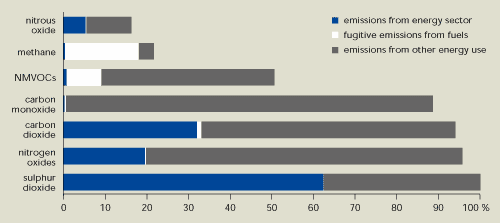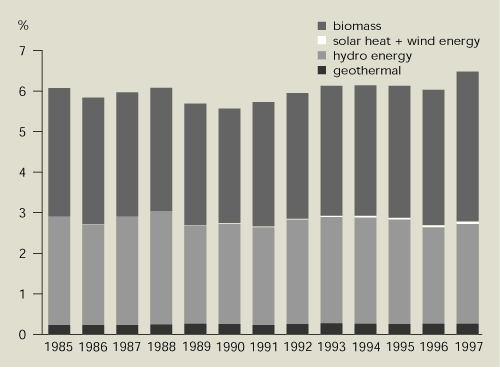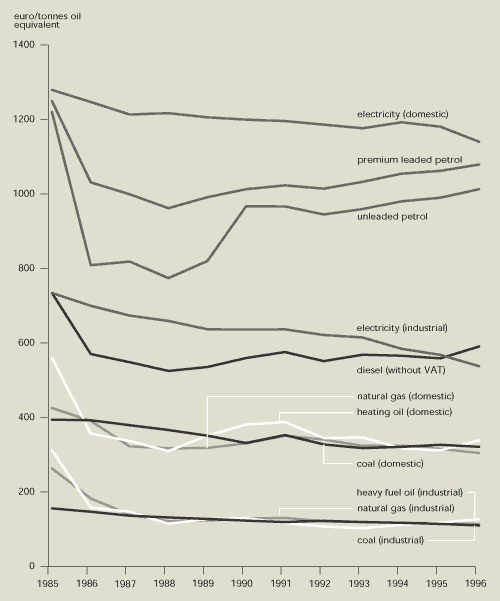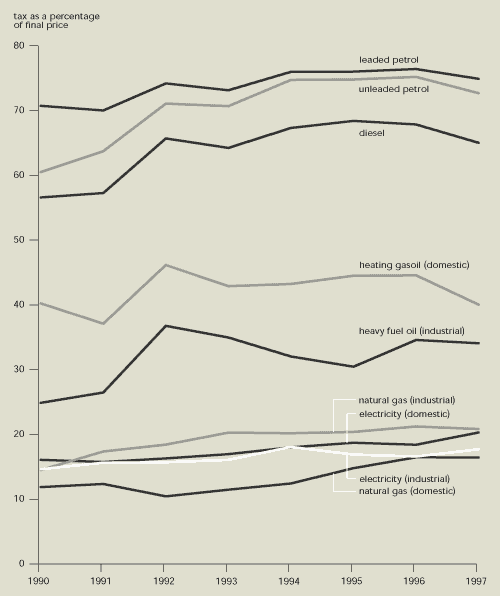3. Energy use
Energy use in EEA member countries
increased during the period 1985-97. Real prices were at low levels
for almost all fuels during this period, which may partly explain
why we consume so much energy. At the same time, energy taxes have
not compensated for the underlying fall in energy prices.
This chapter deals with energy as it is
generated, transformed and used in all parts of society. The next
chapter concentrates on the energy sector, i.e. the economic sector
responsible for the production of energy necessary for the other
sectors (transport, domestic, industry).
General energy policy in the EU is based on
three `pillars' or basic aims: overall competitiveness; security of
supply; and protection of
the environment (European Commission, 1995). Of key importance to
the last objective is to achieve internationally agreed targets for
greenhouse gas emissions (see Chapter 8) and air pollutants
(Chapter 10); energy use is responsible for most of the main
emissions for which targets have been agreed (Figure 3.1).
Figure 3.1. Air emissions from energy
use as a percentage of total air emissions in EU Member States,
1996

Source:
EEA-ETC/AE
Sulphur dioxide emissions from energy use fell
significantly between 1980 and 1996 (see also Figure 10.8). In
1996, the EU as a whole met the sulphur dioxide emission targets
for 2000 set by the UNECE Convention on Long Range Transboundary
Air Pollution (CLRTAP) Second Sulphur Protocol. Nitrogen oxide
emissions also fell during the same period (see also Figure 10.10),
but to a lesser extent.
Total carbon dioxide emissions in the EU from
all sources (including the use of energy) were the same in 1996 as
in 1990 (see Figure 8.3). Carbon dioxide emissions in the EU from
the use of energy — the main source of this greenhouse gas —
increased by nearly 1.5 % between 1990 and 1996. This increase
underlines the need for further initiatives in this area in order
to reach the Kyoto Protocol target.
Factors contributing to emission reductions are
listed in Chapters 8 and 10.
3.1. Trends in energy intensity
Energy use in EEA member countries has
continued to increase over the past decade (Table 3.1). Energy
intensity, i.e. the amount of energy needed to produce a unit of
gross domestic product (GDP), has declined only gradually. This
decrease has been insufficient to allow GDP to grow without an
increase in energy use (Figure 3.2). Between 1985 and 1997,
the GDP in EEA member countries grew, in real terms, by 34 %
compared with a 13 % increase in energy supply. Energy intensity
fell by an average of 1.4 % per year during 1985-97. Most of the
decrease in energy intensity occurred between 1985 and 1990, when
the annual average decrease was 2.0 %. Much less progress (0.9 %)
was observed between 1991 and 1997. Similar levels were observed in
the EU.
Figure 3.2. Energy supply compared with
gross domestic product in EEA member countries, 1985-1997

Source: Eurostat
Note: Gross inland energy
consumption is defined as the total supply of energy used in the
transformation to other products (notably electricity and heat) and
for energy consumption.
 Economic growth continues to demand additional energy
use. The link between growth in gross domestic product and
increased energy use has not been broken.
Economic growth continues to demand additional energy
use. The link between growth in gross domestic product and
increased energy use has not been broken.
It is difficult to determine the effect of
energy-efficiency initiatives, such as the EU's THERMIE and SAVE
programmes, environmental agreements and eco-labelling, on the
overall decrease in energy intensity. The observed decrease in the
EEA member countries is considered not to be notably higher than
the normal improvement expected from `business-as-usual' investment
in new capital stock and measures to save money by avoiding energy
wastage, i.e. autonomous energy-efficiency improvement. The limited
decrease in energy intensity in the EU during 1991-1997 is below
the forecast in the European Commission's conventional wisdom
baseline scenario for 1990-2000 (European Commission, 1996). This
suggests there is room for further energy-efficiency initiatives
and better implementation of existing initiatives.
During the period 1985-1997, the primary energy
source in EEA member countries has been oil (Figure 3.3). Coal was
the second most important fuel in the 1980s, but has been displaced
by gas since 1992. Gas consumption increased from 16 % of gross
inland energy consumption in 1985 to 21 % in 1997 — an increase of
around 50 %. In 1997, nuclear power increased to almost 15 % of
gross inland energy consumption. Renewable energy sources
contributed just over 6 % (and 5.8 % in the EU) in 1997 (Figure 3.4
and Table 3.2).
Figure 3.3. Energy supply sources in EEA
member countries, 1985-1997

Source: Eurostat
 Energy supply in EEA member countries continues to
depend on fuels with significant environmental impacts or risk of
impacts (fossil fuels and nuclear power).
Energy supply in EEA member countries continues to
depend on fuels with significant environmental impacts or risk of
impacts (fossil fuels and nuclear power).
Despite some growth in the use of renewables,
the potential of this energy source to reduce carbon dioxide and
other pollutant emissions is some way from being realised. The EU
target of 12 % use of renewable energy by 2010 will require
significant additional initiatives.
Figure 3.4. Renewables' share of energy
supply in EEA member countries, 1985-1997

Source: Eurostat
 Renewable energy sources
continue to contribute only a small share to the energy supply in
EEA member countries.
Renewable energy sources
continue to contribute only a small share to the energy supply in
EEA member countries.
Due to the small starting base, the
contribution of `high-profile' renewables (wind and solar) to the
energy supply is marginal. However, there has been significant
growth in many EEA member countries. Growth in the use of wind
power and solar heat has been strong, in relative terms, in
Germany, Denmark and Greece as a result of public and private
interest in developing wind power in Germany and Denmark, and solar
water heaters in Greece.
Policies to increase the contribution of
renewable energies include the EU's THERMIE and ALTENER programmes
and national grant programmes for the support of renewable energy.
In some EU Member States, prices for electricity produced from
renewable energy are guaranteed. The European Commission is
currently drafting a proposal for a directive to make current
national systems of support to electricity from renewable sources
compatible within the context of EU liberalised electricity
markets. There are also bottom-up initiatives in some Member States
whereby consumers can buy `green electricity' at a premium, either
through funds or directly (see box `Empowered customers' in Chapter
4).
In 1996, renewables' share of electricity
generation amounted to 9.3 % on average in the EU, but with
considerable variation across EU Member States (see Figure
4.5).
3.2. Trends in energy prices
A likely reason why so much energy is used is
that energy prices are low (Figure 3.5). Historically, energy
demand fell sharply only after the price rises sparked by the 1973
and 1979 oil crises.
The drop in fuel prices since 1985 was mainly
caused by the crash in oil prices in 1986, and the fact that other
fuel prices are often indexed to the oil price. Other factors
included the process of energy market liberalisation in some EU
Member States and the increased liberalisation of world trade with
newly accessible supplies of fuel. The continued development of the
liberalised EU internal energy market is also expected to lead,
within the current policy framework, to some reduction in
prices.
Figure 3.5. Average real
(1990) energy prices in EU Member States, 1985-1996

Source: DG Energy
Notes:
The prices shown are real prices, i.e. the effect of inflation has
been removed. 1990 values were used to deflate. Most of the prices
shown are final prices, with all taxes included. Value-added tax
has been excluded for industry and for diesel. See Eurostat (1999)
for an explanation of the calculation of EU average
prices.
 Between 1985 and 1996, the
price of all fuels remained, in real terms, at low levels, offering
little incentive to reduce fuel use.
Between 1985 and 1996, the
price of all fuels remained, in real terms, at low levels, offering
little incentive to reduce fuel use.
Prices for heavy fuel oil and natural gas for
industry showed the largest fall between 1985 and 1996 (an average
of 7.9 % and 7.3 % per year respectively). Domestic electricity and
premium leaded petrol fell the least, the former falling by 1 % per
year in real terms over the period and the latter by 1.3 %.
During the 1990s, prices rose in real terms for
transport fuels. However, demand for transport fuels showed little
response — demonstrating the `low elasticity of transport demand to
price'. Diesel remains significantly cheaper than unleaded petrol.
This offers little incentive for private car owners to switch from
diesel to less-polluting unleaded petrol.
Without the increase in taxes for many fuels
(Figure 3.6), final fuel prices would have fallen still
further between 1990 and 1997, and the incentive to increase fuel
use could have been even greater.
However, fuel taxes reflect more of an interest
in raising revenue than in reducing fuel use. Revenue from energy
taxes in the EU rose from around ECU 100 billion in 1990 to ECU 158
billion in 1997 (see Chapter 15). Apart from increased taxation
levels, this rise reflects growth in consumption.
Figure 3.6. Taxes as a
percentage of final energy prices in EU Member States,
1990-1997

Source: Eurostat
Notes:
The tax component of industrial energy prices includes both
non-deductible taxes and value-added tax.
 Taxes, as a percentage of final prices, have risen for
almost all fuels. However, the fall in underlying prices and/or
little link between demand and price has given no incentive to
reduce energy use.
Taxes, as a percentage of final prices, have risen for
almost all fuels. However, the fall in underlying prices and/or
little link between demand and price has given no incentive to
reduce energy use.
Taxation policies differ between fuel type and
between the domestic, industrial and transport sectors. Taxes are
highest for transport fuels and much lower in industry — often with
exemptions for particularly energy-intensive industries. Low taxes
for industry reflect government policies not to harm the
competitiveness of their industries in international markets.
At 16 % of the final price, domestic taxes on
natural gas were the lowest of all the fuel taxes in 1997.
Heating-gas oil taxes were much higher. Low taxes reflect, in part,
political concerns about tax rises increasing domestic heating
costs. Energy is often regarded as a basic consumer right for which
governments are responsible to ensure availability, delivery and a
fair price through regulatory and taxation instruments.
| Table 3.1. Gross inland energy
consumption per capita in EEA member countries |
| Unit: tonnes oil
equivalent (toe) per capita |
| |
1985 |
1990 |
1991 |
1992 |
1993 |
1994 |
1995 |
1996 |
1997 |
| Austria |
3.1 |
3.3 |
3.5 |
3.2 |
3.2 |
3.2 |
3.3 |
3.4 |
3.5 |
| Belgium |
4.4 |
4.7 |
4.9 |
5.0 |
4.8 |
4.9 |
5.0 |
5.3 |
5.4 |
| Denmark |
3.8 |
3.5 |
3.9 |
3.7 |
3.8 |
3.9 |
3.9 |
4.4 |
4.1 |
| Finland |
5.5 |
5.7 |
5.8 |
5.6 |
5.8 |
6.0 |
5.7 |
6.0 |
6.4 |
| France |
3.7 |
3.9 |
4.1 |
4.0 |
4.1 |
3.9 |
4.0 |
4.2 |
4.1 |
| Germany |
4.6 |
4.5 |
4.3 |
4.2 |
4.1 |
4.1 |
4.1 |
4.3 |
4.2 |
| Greece |
1.8 |
2.2 |
2.2 |
2.2 |
2.2 |
2.3 |
2.3 |
2.4 |
2.4 |
| Iceland |
7.2 |
8.2 |
7.7 |
7.7 |
7.9 |
7.9 |
8.0 |
8.4 |
n/a |
| Ireland |
2.5 |
2.9 |
2.9 |
2.9 |
2.9 |
3.1 |
3.1 |
3.2 |
3.4 |
| Italy |
2.4 |
2.7 |
2.8 |
2.8 |
2.7 |
2.7 |
2.8 |
2.8 |
2.9 |
| Luxembourg |
8.5 |
9.3 |
9.7 |
9.7 |
9.7 |
9.3 |
8.1 |
8.2 |
8.0 |
| Netherlands |
4.2 |
4.5 |
4.6
|
4.6 |
4.6 |
4.6 |
4.8 |
4.9 |
4.8 |
| Norway |
4.9 |
5.1 |
5.2 |
5.2 |
5.4 |
5.4 |
5.4 |
5.3 |
5.6 |
| Potrugal |
1.2 |
1.7 |
1.8 |
1.9 |
1.9 |
1.9 |
2.0 |
2.0 |
2.1 |
| Spain |
1.9 |
2.3 |
2.4 |
2.4 |
2.3 |
2.5 |
2.6 |
2.6 |
2.7 |
| Sweden |
5.6 |
5.5 |
5.6 |
5.3 |
5.3 |
5.6 |
5.7 |
5.8 |
5.7 |
| UK |
3.6 |
3.7 |
3.7 |
3.7 |
3.7 |
3.8 |
3.8 |
4.0 |
3.8 |
| EU |
3.46 |
3.61 |
3.67 |
3.62 |
3.60 |
3.60 |
3.67 |
3.80 |
3.76 |
| EEA |
3.48 |
3.63 |
3.69 |
3.64 |
3.63 |
3.62 |
3.70 |
3.82 |
3.78 |
| Source: Eurostat |
Notes:
Liechtenstein excluded from all EEA totals. Iceland not included in
the EEA total for 1997.
| Table 3.2. Renewable energy
share of gross inland energy consumption in EEA member
countries |
|
Share (all renewables) (%) |
Share in 1997 (%) |
| |
1990 |
1991 |
1992 |
1993 |
1994 |
1995 |
1996 |
1997 |
Hydro |
Biomass,
waste |
Geothermal,
wind, solar,
other |
| Austria |
22.4 |
20.7 |
23.3 |
24.3 |
22.4 |
23.1 |
23.4 |
23.3 |
10.9 |
12.4 |
0.0 |
| Belgium |
1.6 |
1.5 |
1.5 |
1.4 |
1.4 |
1.6 |
1.5 |
1.4 |
0.0 |
1.1 |
0.2 |
| Denmark |
6.3 |
6.4 |
6.7 |
6.9 |
7.0 |
7.3 |
6.8 |
8.0 |
0.0 |
7.1 |
0.8 |
| Finland |
18.5 |
18.2 |
19.2 |
19.7 |
19.2 |
21.4 |
19.8 |
20.7 |
3.2 |
17.0 |
0.5 |
| France |
5.4 |
7.0 |
7.2 |
6.9 |
7.4 |
7.3 |
6.9 |
6.6 |
2.2 |
4.3 |
0.1 |
| Germany |
1.6 |
1.6 |
1.7 |
1.7 |
1.8 |
1.9 |
1.8 |
2.3 |
0.4 |
1.7 |
0.1 |
| Greece |
5.0 |
5.5 |
5.0 |
5.2 |
5.1 |
5.4 |
5.4 |
5.3 |
1.3 |
3.6 |
0.5 |
| Iceland |
63.2 |
65.5 |
64.3 |
63.4 |
62.8 |
64.4 |
61.8 |
|
18.1 |
0.0 |
43.7 |
| Ireland |
1.6 |
1.7 |
1.6 |
1.6 |
2.2 |
2.0 |
1.6 |
1.8 |
0.5 |
1.3 |
0.0 |
| Italy |
5.4 |
5.9 |
5.9 |
6.1 |
6.4 |
5.6 |
6.0 |
7.9 |
2.1 |
4.0 |
1.8 |
| Luxembourg |
1.3 |
1.2 |
1.3 |
1.2 |
1.3 |
1.4 |
1.2 |
1.4 |
0.2 |
1.2 |
0.0 |
| Netherlands |
1.3 |
1.3 |
1.3 |
1.3 |
1.4 |
1.4 |
1.7 |
2.0 |
0.0 |
1.9 |
0.1 |
| Norway |
52.2 |
46.6 |
48.2 |
47.4 |
45.1 |
47.6 |
42.5 |
41.2 |
38.3 |
2.9 |
0.1 |
| Portugal |
15.8 |
15.6 |
13.2 |
15.9 |
16.0 |
13.9 |
17.9 |
16.9 |
5.3 |
11.3 |
0.3 |
| Spain |
6.7 |
6.6 |
5.7 |
6.5 |
6.5 |
5.7 |
7.2 |
6.5 |
2.8 |
3.6 |
0.1 |
| Sweden |
24.6 |
22.7 |
26.4 |
27.3 |
23.8 |
25.6 |
22.7 |
26.7 |
11.8 |
14.9 |
0.0 |
| UK |
0.5 |
0.5 |
0.7 |
0.7 |
0.9 |
1.0 |
0.9 |
0.9 |
0.2 |
0.7 |
0.0 |
| EU |
4.7 |
5.0 |
5.2 |
5.3 |
5.4 |
5.3 |
5.4 |
5.8 |
1.8 |
3.7 |
0.3 |
| EEA |
5.5 |
5.7 |
5.9 |
6.0 |
6.0 |
6.0 |
5.9 |
6.4 |
2.4 |
3.7 |
0.3 |
| Source: Eurostat |
Notes: Liechtenstein excluded
from all EEA totals. Iceland not included in the EEA total for 1997
and 1996 data used for its specific renewables share.
3.3. References and further reading
European Commission (1995). An energy
policy for the European Union — White Paper of the European
Commission. COM(95)682 final. European Commission,
Brussels.
European Commission (1996). European Energy
to 2020. A scenario approach. Energy in Europe, special issue.
European Commission, Brussels.
European Commission (1997). The White Paper
for a Community strategy and action plan. COM(97)559 final.
European Commission, Brussels.
European Commission (1998a). Strengthening
environmental integration within community energy policy.
COM(1998)571 final. European Commission, Brussels.
European Commission, DG Energy (1998b).
Energy in Europe. 1998 annual energy review, special issue.
European Commission, Brussels.
Eurostat (1999). Integration indicators for
energy. Key indicators series. European Communities,
Luxembourg.






Document Actions
Share with others